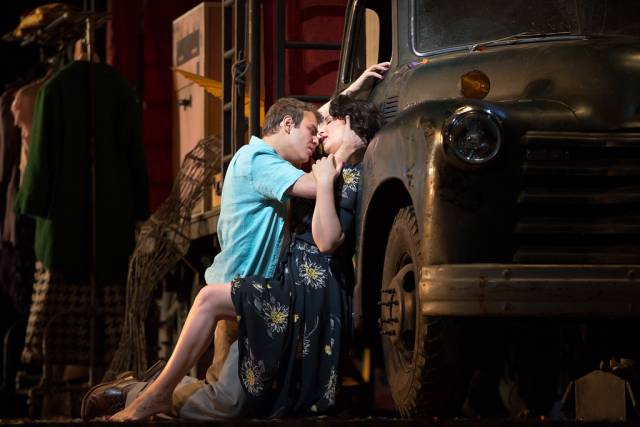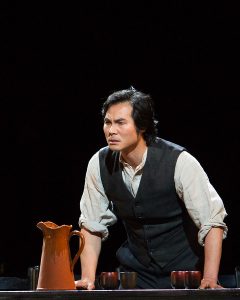

The classic operatic double feature, Cavalleria Rusticana (Rustic chivalry) and Pagliacci (the clowns) is almost as sure as La Bohème to please Italian opera fans and newcomers alike. In fact, each of these short operas is almost never performed without the other; the duo presents a combination as enduringly popular as linguini and clams. Both are classic examples of opera verismo (realism), a genre that was developed in the 19th century to satisfy audiences who’d grown weary of gods and mythic tales. Verismo is the kind of opera that hooks new fans every time.
Pietro Mascagni’s Cavalleria Rusticana is the ultimate gritty, Sicilian vendetta story; a drama of small town passion, betrayal and revenge so picturesque and theatrical that it was featured in the climax of The Godfather Part III. (There is also a wonderful filmed version made on location by Franco Zeffirelli.) The opera tells the story of Turiddu, a young man in a remote Sicilian village who has rekindled an affair with his old flame Lola, despite the fact that she has recently married. Ruggero Leoncavello’s Pagliacci is the story of a traveling clown’s heartbreak upon discovering his wife’s unfaithfulness. He carries on with the show while plotting bloody revenge. The sad clown Canio, dressed in a white Pierrot costume, has become a classic image of Italian opera, appearing in posters and on album covers.
The Met’s new production sets both operas in the same rural town and captures the look and feel of Italian neorealist cinema. Pagliacci, traditionally the second piece performed, seems to have sparked the imagination of director David MacVicar more than its counterpart. It is more successfully staged than Cavalleria Rusticana; in fact it is one of the most imaginatively and skillfully directed operas I’ve seen in recent years, and this makes the duller staging of Cavalleria all the more noticeable. The Leoncavallo piece almost seems like an afterthought. Most regrettable is the near total absence of the town’s church, a key element in the opera.
But this Pagliacci really works. The performers successfully echo the earthy characters of classic Italian postwar cinema, especially soprano Barbara Frittoli as Nedda. Full of humor and surprises, Pagliacci’s play-within-a play is highly entertaining, witty and clever. The marvelous use of costumes and even puppetry as the traveling show is performed before an entire town of villagers makes it all the more enjoyable. The appearance of Canio in his clown costume and makeup, while nothing like the traditional image of him (it’s quite Chaplinesque), is heartbreakingly perfect for the character and for his classic aria, “Vesti la Guibba” (put on the costume), also known as “Ridi Pagliaccio” (laugh, clown), from the climactic lyric that is always sung with heartbreak. Tenor Roberto Alagna performs the aria supremely well in one, before a striking blue curtain that illustrates the theatricality of what is happening to him. George Gagnidze is marvelous as Tonio, both in voice and in a wonderful comic performance.

While not as well staged, this Cavalleria Rusticana is certainly enjoyable. Musically, it is presented very well. Conductor Fabio Luisi leads the orchestra into the freshest, most delicate performance of this piece I have ever heard, and that includes a Met performance of the acclaimed Zeffirelli production a few years back. The famous intermezzo, heard so often in movies (Raging Bull, most famously) is played softer and gentler than I’ve ever heard it played before. At no time do the strings or brass hammer the emotions home, instead they gently coax deep, rich feeling from the melody. It is exquisite. Tenor Yonghoon Lee sings Turiddu with power and emotion, his voice almost deep enough to be a baritone. Was this due to the cold we were warned about? Nevertheless he was wonderful right up to the tragic climax. His performance has just the right touch of arrogance to make the story work without making the audience actually hate him, despite the fact that he is essentially the story’s villain as well as its romantic lead. As with Pagliacci, the entire cast is strong, especially Ambrogio Maestri as Alfio, husband to Lola and Turiddu’s rival.
If Cavalleria’s staging could be uncluttered a bit and given just a few more directorial flourishes to heighten its dramatic power, this double bill could become a classic of the Met, and it could have a grand future entertaining opera fans for decades to come.
Performances of Cavalleria Rusticana/Pagliacci continue through February 26. For more information and tickets, visit metopera.org.